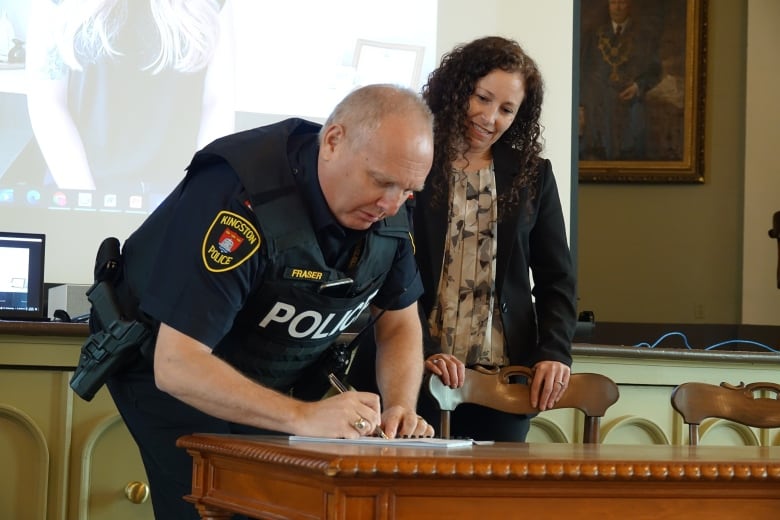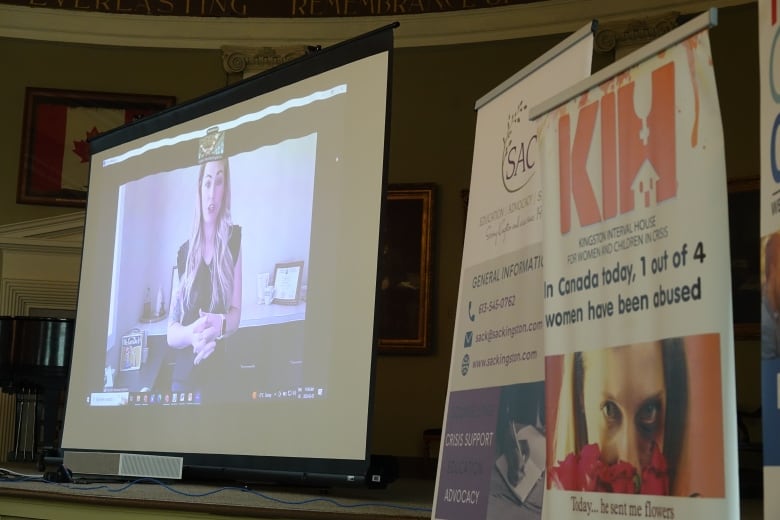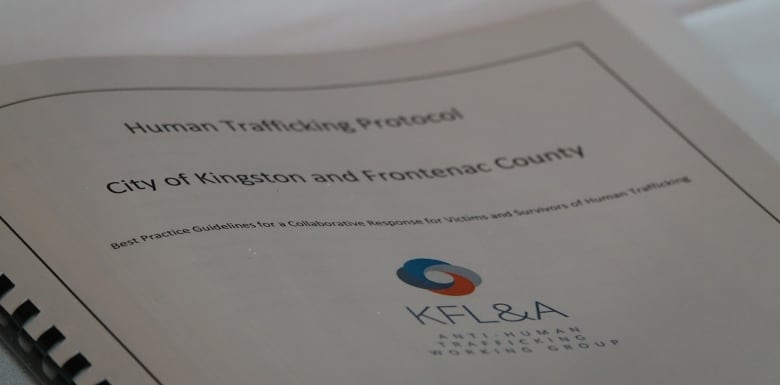Kingston region creates strategy to support survivors of human trafficking | CBC News
Alexandra Stevenson describes Kingston and Frontenac County's new human trafficking protocol as a declaration that no one is going to fall through the cracks.
Stevenson, who called herself both a victim and survivor of human trafficking, helped review the document, which was signed by representatives of the public school board, community organizations and law enforcement Tuesday morning.
“This protocol is the spark of light helping victims to identify the truth of what is happening to them, and to regain control over their lives,” she said, speaking by Zoom to a room full of signatories during a ceremony at Kingston City Hall.
“This protocol is the creation of a safe space for survivors to lay down their shame, their self-blame and begin their healing process.”
The region is the fourth in Ontario to create such a protocol, according to Lana Saunders, chair of the Kingston, Frontenac, Lennox & Addington (KFL&A) anti-human trafficking working group.
She called the document a roadmap to local services and a commitment to collaboration.
Its goal is to offer victims consistent support and information while allowing the agencies who work with them to develop best practices and receive regular training.
“I really, really hope this is going to increase public education and awareness,” said Saunders.
“We need to work together to ensure all of the needs are met for our victim survivors.”
Location provides opportunity
The protocol notes all members of the working group have noticed an increase in the number of victims of human trafficking who are using their services.
It also points to the region's location between Toronto and Montreal, describing the bigger cities as “established trafficking hubs.”
Kingston's acting police chief Scott Fraser was among those who signed the protocol.

He said the area has seen both sex trafficking and people being trafficked for labour.
“It's a midway point, it's easy access to [Highway] 401,” he explained. “It just provides an excellent opportunity and whenever there's opportunity that's where we see these types of actions taking place.”
Stevenson told the group she was trafficked by her boyfriend in the Toronto area in 2007, but it took her roughly a decade to realize that's what had happened.
Now she hopes to help others facing similar circumstances.
“We need service providers who will work together hand-in-hand to stop and fill the cracks that we're falling through,” she said, adding she was proud to take part in the protocol.

Saunders said trafficking can take on numerous forms and might not always be easy to identify.
“You could potentially have a girl who's going to a local high school by day and being worked in the evenings or on weekends,” she explained.
One reason the protocol is so crucial is that it brings all service providers and law enforcement together, she added, so they're prepared to offer whatever a survivor needs at the moment they're ready to reach out for assistance.
“You have to make sure everything is in place and there's no gaps in services,” said Saunders.
If the community isn't prepared to surround them in support “it's not fair to ask them to come forward and seek help.”

This “Eyes on Trafficking” story is reprinted from its original online location.
 ABOUT PBJ LEARNING
ABOUT PBJ LEARNING
PBJ Learning is a leading provider of online human trafficking training, focusing on awareness and prevention education. Their interactive Human Trafficking Essentials online course is used worldwide to educate professionals and individuals how to recognize human trafficking and how to respond to potential victims. Learn on any web browser (even your mobile phone) at any time.
More stories like this can be found in your PBJ Learning Knowledge Vault.
EYES ON TRAFFICKING
This “Eyes on Trafficking” story is reprinted from its original online location.
ABOUT PBJ LEARNING
PBJ Learning is a leading provider of online human trafficking training, focusing on awareness and prevention education. Their interactive Human Trafficking Essentials online course is used worldwide to educate professionals and individuals how to recognize human trafficking and how to respond to potential victims. Learn on any web browser (even your mobile phone) at any time.
More stories like this can be found in your PBJ Learning Knowledge Vault.
